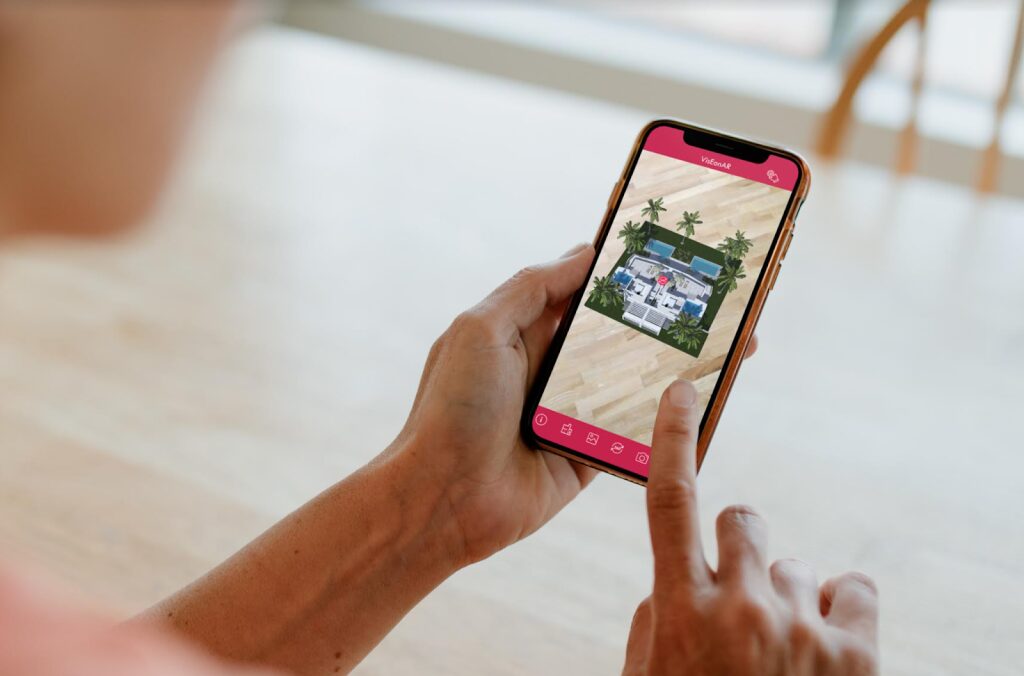The real estate industry is now in its innovative era, embracing the latest technology to deliver out-of-this-world customer service and brand marketing. There has been enough talk about 3D walk-throughs. The new player in the arena is an AR technology that combines the virtual world with the world we all live in. Implementing AR solutions into the real estate business is a proven way to achieve rapid client growth and sales increase. Enhance the things we see, hear, and feel with the augmented reality services by VisEngine.
Let’s dive deep into how AR can transform your real estate business.
What AR technology means for the real estate industry?
Augmented reality technology overlays virtual elements onto the real world, allowing buyers to visualize properties, design choices, and more. AR is one of a kind of interactive and immersive experience to evaluate real estate. With AR, users can explore how different furniture or features would look in a real space, interacting with the property in real-time.
The Insight Partners agency revealed that the AR market is forecasted to grow to $252.16 billion by 2028 while only estimated at $27.96 billion in 2021. The augmented reality market is one of the most rapid-growing niches worldwide, and the real estate industry takes a significant share of it.
Are there any successful real-life cases? Let’s focus on that for a moment.
- Street Peak Realtor App: With this AR app, users can point the phone at a building or property to access all the relevant information, like the number of rooms or estimated value, to help potential buyers interactively evaluate properties.
- IKEA AR app: In 2017, major brand IKEA launched an AR App to provide an immersive shopping experience, allowing customers to access the online catalog at home and feel different items in the context of their own space.
- RealAR: This app is heaven for architects. RealAR visualizes various designs in virtual reality to let users see how their fantasy feels outside their imagination.
- Astralink: This app is a time-saver for construction workers. Astralink shows the amount of work and resources needed to complete the ongoing project and where which details should go, making the constriction work way more efficient.
AR in your business: Benefits for real estate
AR solutions are empowering tools for any real estate business with numerous benefits for both professionals and customers.

- Mind-blowing product visualization
The most obvious benefit is letting buyers see something that is not physically present. With AR technology, clients can visualize how the construction site will feel in a month or two, what design choices work in the space, or how new furniture piece compliments the room Instead of channeling their imagination. Such interactive experience stimulates the desire to buy and learn more about the property, which is a win-win situation for real estate professionals and buyers.
- Innovative marketing and advertisement tools
Interactive digital solutions work wonders for real estate marketing. AR-powered ads can raise brand awareness, increase the company’s outreach and boost user engagement on social media platforms and websites. By improving the discoverability of their business, realtors can generate new high-quality leads and guarantee a rapid increase in sales.
- Time-saver
AR can protect the most valuable resource you have – time. AR-powered virtual tours reduce the number of in-person property visits, allowing realtors to multiply showing per day without leaving their workplace. At the same time, buyers can attend several virtual visits, making the important purchase much faster.
- Optimized client behavioral data analysis
AR app can provide valuable data showing how users interact with the virtual tours, what features they look for, and the least engaging aspects. Based on the analysis, realtors can optimize their future presentations, navigating the customer experience and improving client satisfaction.
- Revolutionizing the market
AR technology has the potential to transform the real estate industry by creating new business models and services. It offers an innovative way for home buyers to explore the market, giving the business more opportunities to stay ahead of its competitors.
4 steps for implementing AR in the already-existing business
Do you feel like AR is a must-have solution but don’t know where to start? Here is an easy guide to help you understand the AR implementation process.
- Step 1. Design. Research how AR fits into existing business strategies. Determine the goals you plan to achieve with AR, the types of experience you plan to provide for customers, and how it helps the business to stay ahead of the competitors.
- Step 2. 3D model creation. Whether working with a third-party or in-house team, you should create 3D models of the products or services to showcase using AR.
- Step 3. Building AR framework. Connect all the pieces in the AR framework, like sounds, light, and atmosphere. Consider how small detail reflects your business goals and current project to help create an effective AR tool.
- Step 4. Final testing. Don’t skip the last step if you want ground-breaking results. Consult with tech professionals, real-life customers, or focus groups to ensure your AR solution is user-friendly, engaging, and effective.
The bottom line
It is safe to say that augmented reality is a breakthrough in customer service and marketing for the real estate industry. Highly beneficial technology can empower professionals to reach new heights in business and expand their services.
Ready to transform your business but don’t want to bother with hiring an in-house team? You can always trust a professional digital agency with years of experience in the VR/AR field and cutting-edge tech to create solutions on edge between reality and fantasy. With the specialists like Visengine, you can focus on your business processes when they deliver mind-blowing AR tools to empower your brand for unrealistic success.






